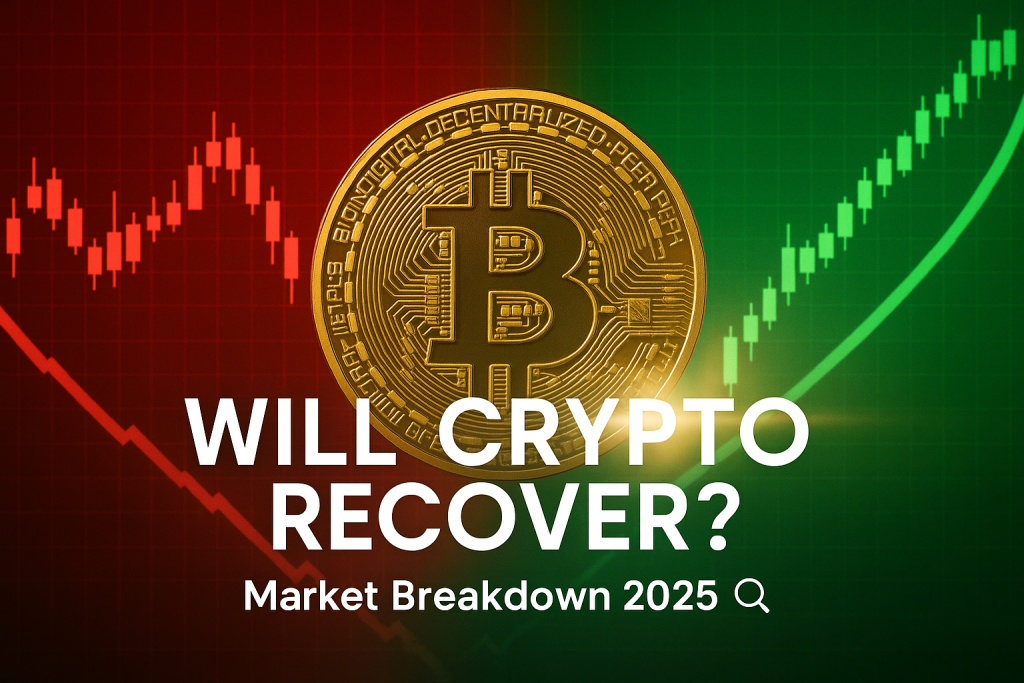The cryptocurrency market has once again found itself in turbulent waters. Prices that once seemed unstoppable have tumbled sharply, wiping out billions in market value. Investors are asking familiar questions — why crypto crashed? Will it recover? Will crypto bounce back?
Understanding these answers is key not only for peace of mind but also for making smarter investment decisions. This guide breaks down exactly what’s causing the 2025 crypto crash, how similar events unfolded in the past, and what signals to watch for the next recovery.
Understanding the 2025 Crypto Market Crash
The recent market crash in October 2025 has shaken the crypto world. Bitcoin, Ethereum, and most major altcoins have lost significant value within days. To understand what happened, let’s look at both the immediate triggers and the deeper structural causes.

What Triggered the Recent Crash?
The latest crash started with a wave of fear linked to renewed U.S.-China trade tensions. When President Donald Trump announced new 100% tariffs on Chinese goods, global markets panicked — and crypto, being a high-risk asset, was hit hardest.
As traders began selling, a chain reaction occurred. Many investors were trading with high leverage — borrowing money to amplify their gains. When prices dropped, their positions were automatically liquidated, causing even more selling pressure.
In less than 48 hours, over $19 billion worth of leveraged crypto positions were wiped out — one of the largest liquidation events in history. This “weekend wipeout” created a downward spiral across Bitcoin, Ethereum, Solana, and altcoins, leading to a massive price crash.
The Role of Global Events and Macroeconomics
The tariff threat was just the spark. The fuel came from global economic pressures that had been building throughout 2025.
- Rising inflation fears: The Consumer Price Index (CPI) reports showed inflation running hotter than expected.
- Federal Reserve inaction: The U.S. Federal Reserve chose not to cut interest rates, signaling tighter money conditions for longer.
- Investor caution: As economic uncertainty grew, investors pulled money out of risky assets like crypto and moved into safer ones such as government bonds and gold.
These macroeconomic factors combined with geopolitical tension to trigger a broad “risk-off” environment. Crypto, once seen as a hedge against inflation, became correlated with tech stocks and started moving down alongside them.
How Technical Factors Amplified the Fall
Crypto markets are heavily driven by technical dynamics — and when the market turns bearish, these can worsen the decline.
- Excessive Leverage: Many traders were using 20x, 50x, or even 100x leverage. When prices dropped slightly, automated systems liquidated positions, causing a cascade of forced selling.
- Low Liquidity in Altcoins: Smaller cryptocurrencies like Cardano, Solana, and Dogecoin saw massive price swings because of thin trading volumes.
- Market Manipulation: “Whales” — large holders — sold at the top, creating panic that pushed prices even lower.
This combination of overleveraged trading and emotional reaction magnified what might have been a mild correction into a full-blown crash.
Why Does Crypto Crash So Often?
Crypto crashes are not new. Since Bitcoin’s creation, the market has experienced several major collapses — and every time, it has eventually bounced back. But to understand why crypto crashes happen so frequently, we need to look at the core characteristics of this market.
Volatility and Speculation
Crypto is still a young, fast-moving market driven largely by speculation. Many traders buy and sell based on emotions rather than fundamentals. When prices rise, FOMO (fear of missing out) takes over; when they fall, panic selling spreads quickly.
Because there are no guaranteed earnings, intrinsic cash flow, or valuations, crypto prices depend heavily on market sentiment. When that sentiment turns negative, even small triggers can lead to massive crashes.
Regulation and Legal Uncertainty
Regulation remains one of crypto’s biggest unknowns. Governments worldwide are tightening their oversight of digital assets:
- In the United States, the SEC continues to pursue cases against major exchanges.
- In Europe, new MiCA rules have introduced stricter compliance for stablecoins and crypto service providers.
- China maintains its longstanding ban on trading and mining.
Every regulatory announcement affects investor confidence. While long-term clarity is good, short-term uncertainty can lead to rapid sell-offs.
Bitcoin’s Dominance and Market Psychology
Bitcoin is often called the heartbeat of the crypto market. When Bitcoin moves, the rest of the market follows. During crashes, investors typically sell altcoins first and move their funds into Bitcoin or stablecoins, increasing Bitcoin’s market dominance.
This “flight to safety” makes altcoins fall even harder. As Bitcoin drops, fear spreads, and small-cap tokens can lose 50% or more in days. The entire market moves in sync, showing how tightly correlated digital assets have become.

Will Crypto Recover from This Crash?
The big question remains — is this the end, or just another correction?
If history is any guide, crypto always recovers — though the timing and pace vary depending on global and market conditions.
Historical Patterns of Recovery
Looking back, crypto has endured multiple massive crashes — and every single one has been followed by recovery and growth:
- 2013–2014: Bitcoin fell from $1,100 to under $200 after the Mt. Gox collapse. Two years later, it surpassed $1,000 again.
- 2018: Following the ICO bubble burst, the market lost over 80% of its value. By 2020, Bitcoin had regained momentum and hit new highs.
- 2022: The FTX collapse sent Bitcoin below $16,000, yet by 2024 it reached a record above $100,000.
These examples show that crashes, while painful, tend to “reset” the market and pave the way for healthier growth.
Bitcoin Halving and Market Cycles
One of the most reliable patterns in crypto’s history is the Bitcoin halving cycle. Every four years, Bitcoin’s mining reward is cut in half, reducing new supply and often triggering a bull market afterward.
The most recent halving occurred in April 2024, and history suggests that the following 12–18 months often bring price appreciation.
- After the 2016 halving, Bitcoin rose from $600 to $20,000 by 2017.
- After the 2020 halving, it went from $9,000 to $69,000 in 2021.
Following this trend, 2025 could be the “mid-cycle correction” — a temporary dip before another potential bull run.
Institutional Confidence and Adoption
Despite volatility, institutional interest in crypto remains strong. Companies like BlackRock, Fidelity, and PayPal continue developing crypto-based products. Global payment networks like Visa and Mastercard are integrating blockchain technology.
This ongoing adoption suggests that the market is maturing. Institutional players often view downturns as buying opportunities rather than exit signals.
Meanwhile, new Bitcoin ETFs have drawn billions in inflows, signaling that big money is not abandoning the space — just waiting for stability before re-entry.
Signs to Watch for a Rebound
If you’re trying to spot early recovery signals, keep an eye on:
- Bitcoin’s RSI (Relative Strength Index) – Values below 40 often indicate oversold conditions.
- Whale Accumulation – When large holders start buying again, it shows renewed confidence.
- On-Chain Data – Declining exchange reserves usually mean investors are moving coins to cold storage, signaling long-term holding.
- Fear & Greed Index – Extreme fear (below 20) historically marks market bottoms.
When these indicators align with positive macroeconomic trends — such as falling interest rates or easing inflation — recovery is usually near.

How to Prepare for Future Crypto Crashes
Crashes are inevitable, but they don’t have to destroy your portfolio. What separates successful investors from the rest is how they react during downturns.
Here’s how to build resilience for the future.
Strategy Over Emotion
One of the biggest mistakes investors make is reacting emotionally. Panic selling often locks in losses. A calm, long-term approach is far more effective.
Dollar-cost averaging (DCA) — investing a fixed amount regularly regardless of price — helps smooth out volatility. By buying small amounts over time, you reduce the risk of buying at the top and benefit from lower prices during dips.
Patience and consistency almost always outperform fear and impulse in the crypto world.
Diversification and Risk Management
Never put all your funds into one asset or token. Diversify across different types of investments — major coins like Bitcoin and Ethereum, stablecoins, and perhaps some traditional assets such as stocks or ETFs.
Avoid over-diversification, though. Holding dozens of speculative coins spreads your attention too thin and increases exposure to low-quality projects. A focused, diversified strategy works best.

Learn from Experts
Crypto veterans and traditional finance experts often provide timeless investing wisdom.
- Warren Buffett, one of the world’s most respected investors, calls crypto “speculative” but acknowledges that markets always correct excesses. His philosophy of focusing on real value applies here — invest in assets with purpose and durability.
- Dave Ramsey, known for financial discipline, advises avoiding high-risk assets altogether. While that might be too conservative for some, his focus on long-term financial health is a valuable reminder to avoid emotional, all-in bets.
- At the same time, many millionaires and institutional investors still hold small crypto positions — usually under 5% of their portfolios — as high-risk, high-reward exposure. The key is balance.
Focus on Quality Projects
Not every cryptocurrency will survive each cycle. Many tokens created during bull markets disappear after crashes. Focus on assets with real utility, active developer teams, and strong communities.
Projects leading in layer 2 scaling, real-world asset tokenization, decentralized finance (DeFi), and interoperability are likely to endure. Avoid chasing hype; instead, choose coins that solve actual problems.
Keep Learning and Stay Updated
Bear markets are the best time to learn. Without the noise of hype, you can study real fundamentals — blockchain technology, tokenomics, and market structure.
Stay informed through credible sources rather than social media rumors. Always double-check information and avoid influencers promising unrealistic profits.
Knowledge compounds like interest — the more you understand the market, the more confidently you’ll navigate future volatility.
What to Watch in the Next Cycle
The next 12–24 months could define the future of crypto. Here’s what to monitor:
- Federal Reserve rate decisions – Interest rate cuts often reignite investment flows.
- Global trade policies – Tariff resolutions or easing tensions could stabilize markets.
- New ETF approvals – Especially for Ethereum and Solana, which may boost adoption.
- AI and blockchain integration – As artificial intelligence and blockchain merge, new innovations could fuel a fresh wave of growth.
By watching these factors early, investors can position themselves before the next big move begins.
Faqs
Why crypto is crash?
Crypto crashes when investor confidence declines due to global events, regulatory actions, or economic changes. In 2025, the combination of U.S.-China tariffs, inflation concerns, and excessive leverage caused panic selling and record liquidations.
What does Warren Buffett say about crypto?
Warren Buffett has long warned that cryptocurrencies lack intrinsic value and behave more like speculative assets than investments. He advises focusing on businesses that produce real goods or services. Still, his broader message about risk and patience applies perfectly to crypto investing.
Do millionaires invest in crypto?
Yes. Many millionaires include crypto in their portfolios, but usually in small amounts — often less than 5%. They treat it as a speculative or alternative asset class, balancing it with more stable investments like stocks, bonds, or real estate.
What does Dave Ramsey think of cryptocurrency?
Dave Ramsey discourages investing in cryptocurrencies due to their volatility and lack of predictable returns. He believes in building wealth through steady, long-term investments. However, he acknowledges blockchain as an emerging technology with potential for future innovation.
Is crypto going to recover?
History suggests yes. Every major crash has been followed by a recovery as adoption, technology, and regulation mature. While timing remains uncertain, long-term trends point toward gradual stabilization and renewed growth.
Will crypto crash again?
Probably — crypto is inherently volatile. Crashes and corrections are part of its cycle. What matters is not avoiding crashes entirely but being prepared to handle them wisely.
Final Thought
Crypto markets move in cycles — periods of excitement, correction, and renewal. The 2025 crash is a reminder that volatility is the price of innovation.
This downturn was driven by global events, economic tightening, and excessive speculation, but it doesn’t spell the end. The fundamentals of blockchain adoption, institutional interest, and innovation remain strong.
History has shown one clear pattern: every crash eventually gives birth to the next recovery. Investors who stay calm, informed, and disciplined are the ones who benefit most when the tide turns.
Whether crypto recovers in months or years, one thing is certain — it will evolve, adapt, and continue to shape the future of finance. For those who understand the game, today’s crash may well be tomorrow’s opportunity.


